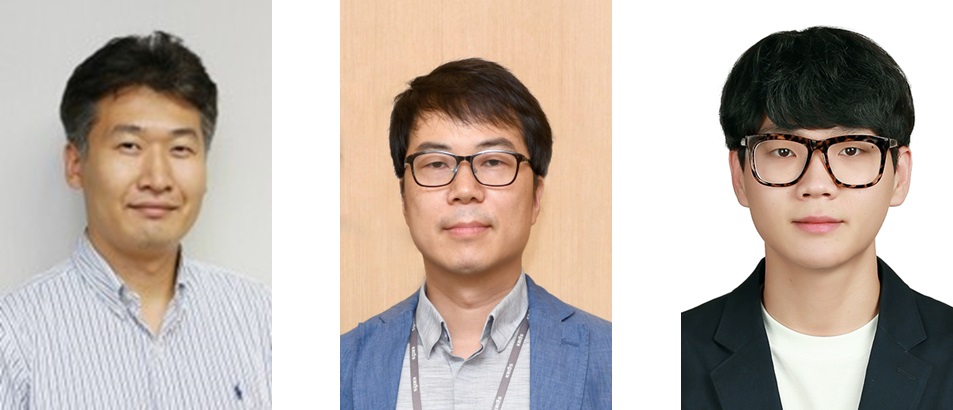Revolutionary thermoelectric materials enable waste heat recovery from affordable, environmentally friendly materials
High-performance thermoelectric materials achieved using zinc oxide and graphene composites
New possibilities for applications in eco-friendly energy conversion technology
Prof. Jeon Seok-woo’s team publishes results in Nature Communications

▲ (From left) Prof. Jeon Seok-woo (corresponding author, Department of Materials Science and Engineering), Shin Ho-sun (co-corresponding author, KRISS principal researcher), Choi Myung-woo (first author, post-doc researcher)
The team led by Professor Jeon Seok-woo of the Department of Materials Science and Engineering has developed a groundbreaking method for producing thermoelectric materials using inexpensive and environmentally friendly materials for waste heat recovery.
This research was conducted in collaboration with the team led by Dr. Shin Ho-sun from the Korea Research Institute of Standards and Science. The results were published online in Nature Communications (IF: 16.6) at 7:00 PM (Korean Standard Time) on March 14.
* Title of paper: High Figure-of-merit for ZnO Nanostructures by Interfacing Lowly-Oxidized Graphene Quantum Dots
* Author information: Choi Myung-woo (first author, post-doc researcher), An Ju-young (co-first author, KAIST PhD program), Shin Ho-sun (co-corresponding author, KRISS principal researcher), Prof. Jeon Seok-woo (corresponding author, Department of Materials Science and Engineering)
Thermoelectric technology is an environmentally friendly energy conversion technology that converts heat, such as solar heat, body heat, and waste heat, into electricity through the conversion of energy between heat and electricity.
Typically, thermoelectric technology supports both the "generation effect using heat" and the "cooling effect using electricity." This technology has garnered attention due to its wide-ranging applicability from waste heat recovery in traditional industries to advanced industrial fields such as energy harvesters and self-powered sensors.
The energy conversion efficiency of thermoelectric materials is determined by the "dimensionless figure-of-merit (zT)" where efficient heat-electricity conversion is achieved by facilitating electrical conductivity within the material while suppressing heat flow. As such, it is necessary to design materials with a high electrical conductivity and Seebeck coefficient※, but low thermal conductivity.
※ Seebeck coefficient: The extent to which the temperature difference between the two ends of a thermoelectric material is converted into electrical power
Due to the advantages of thermoelectric technology, a range of research and development effort is being made into thermoelectric materials. However, thermoelectric materials that exhibit high energy conversion efficiency have been limited to expensive and toxic substances.
The research team focused on zinc oxide (ZnO), which is inexpensive and environmentally friendly and can be produced using widely available processes. However, zinc oxide has the drawback of having a low dimensionless figure-of-merit (zT) due to its high thermal conductivity, which allows heat to flow rapidly.
The research team utilized advanced nano semiconductor processes to effectively hinder the heat flow of zinc oxide. They fabricated "3D nano-shell structured zinc oxide" with numerous holes ranging in size from 200 to 300 nanometers (nm, one billionth of a meter) and following a regular alignment pattern.
Heat in materials is transmitted by phonons※. Unlike conventional bulk zinc oxide, the 3D nano-shell structured zinc oxide developed by the research team effectively hinders the movement of these phonons at numerous nanostructure interfaces, resulting in an over tenfold reduction of thermal conductivity compared to that previously reported for zinc oxide.
※ Phonon: A quasi-particle representing quantized vibrations of the crystal lattice. Heat flows within a material due to the movement of phonons.
Coating the zinc oxide nanostructure surface with graphene quantum dots (GQD)※, which can be mass-produced inexpensively, allowed additional graphene surfaces to form outside the zinc oxide nanostructure surface. This further suppressed the movement of phonons, reducing thermal conductivity by over 40 times compared to that previously reported for zinc oxide. Additionally, the graphene surface effectively induced the energy filtering effect※, maximizing the voltage generated by the temperature difference between the ends of the material and enhancing the Seebeck coefficient.
※ Graphene quantum dots (GQD): 1D carbon nano-materials composed of hexagonal honeycomb carbon structures cut to nanometer sizes. They have a controlled discrete energy band gap of approximately 3.2 eV, consisting of carbon and oxygen, and this makes them non-toxic and stable, such as against oxygen, moisture, and heat.
※ Energy filtering effect: A phenomenon where the transport of low energy charges is blocked at the interface energy barrier, allowing only high energy charges to be selectively transported, thereby increasing the Seebeck coefficient.
This approach, due to the significant reduction in thermal conductivity and improvement of the Seebeck coefficient, produces a dimensionless figure-of-merit (zT) in the intermediate temperature range (350℃) of 0.486, the highest value reported for zinc oxide materials.
The nanostructuring and graphene composite strategies developed by the research team have paved the way for achieving a high thermoelectric performance with zinc oxide, something previously unattainable. This advancement is expected to ensure both environmental friendliness and economic feasibility by utilizing the waste heat generated in factories, automobiles, and electronic components to produce electricity or by application to electronic thermoelectric cooling devices that do not require refrigerants.
Professor Jeon Seok-woo of the Department of Materials Science and Engineering stated, "This groundbreaking research utilizes materials with low thermoelectric performance as high-value-added materials through nanostructuring and graphene composites." He added, "Thermoelectric power generation technology, which has been limited to specific fields due to price, environmental issues, and performance limitations, can now be broadly applied to varied fields."
This research was conducted with support from the Future Materials Discovery Program and Future Technology Research Laboratory Program of the National Research Foundation of Korea, the Research Leader Support Program of the National Research Foundation of Korea, and the Basic Research Program of the Korea Research Institute of Standards and Science (KRISS).
<Fig. 1>
![[Fig. 설명] 열전소재의 3차원 나노 구조화 전략을 통한 열전 성능 향상](/dext5editordata/2024/03/20240319_103359971_73145.jpg)
[Caption] Enhancement of thermoelectric performance through 3D nanostructuring of thermoelectric materials
<Fig. 2>
![[Fig. 설명] 산화아연/그래핀 양자점 3차원 나노구조 복합소재 모식도](/dext5editordata/2024/03/20240319_103420166_90313.jpg)
[Caption] Schematic diagram of zinc oxide/graphene quantum dot 3D nanostructured composite materials
<Fig. 3>
![[Fig. 설명] 산화아연/그래핀 양자점 3차원 나노구조 복합소재의 열전 성능 비교](/dext5editordata/2024/03/20240319_103523791_18840.jpg)
[Caption] Comparison of thermoelectric performances of zinc oxide/graphene quantum 3D nanostructured composite materials



